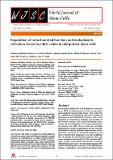Por favor, use este identificador para citar o enlazar a este item:
http://hdl.handle.net/10261/165593COMPARTIR / EXPORTAR:
 SHARE SHARE
 CORE
BASE CORE
BASE
|
|
| Visualizar otros formatos: MARC | Dublin Core | RDF | ORE | MODS | METS | DIDL | DATACITE | |

| Título: | Regulation of mitochondrial function and endoplasmic reticulum stress by nitric oxide in pluripotent stem cells |
Autor: | Caballano-Infantes, Estefanía CSIC ORCID; Terrón-Bautista, José CSIC ORCID; Beltrán-Povea, Amparo CSIC; Cahuana, Gladys M. CSIC; Soria Escoms, Bernat CSIC ORCID; Nabil, Hajji; Bedoya Bergua, Francisco Javier CSIC ORCID; Tejedo Huamán, Juan Rigoberto CSIC ORCID | Palabras clave: | Nitric oxide Endoplasmic reticulum stress Mitochondrial function Pluripotency Cell differentiation Mitochondrial biogenesis |
Fecha de publicación: | 2017 | Editor: | Baishideng Publishing Group | Citación: | World Journal of Stem Cells 9(2): 26-36 (2017) | Resumen: | Mitochondrial dysfunction and endoplasmic reticulum stress (ERS) are global processes that are interrelated and regulated by several stress factors. Nitric oxide (NO) is a multifunctional biomolecule with many varieties of physiological and pathological functions, such as the regulation of cytochrome c inhibition and activation of the immune response, ERS and DNA damage; these actions are dose-dependent. It has been reported that in embryonic stem cells, NO has a dual role, controlling differentiation, survival and pluripotency, but the molecular mechanisms by which it modulates these functions are not yet known. Low levels of NO maintain pluripotency and induce mitochondrial biogenesis. It is well established that NO disrupts the mitochondrial respiratory chain and causes changes in mitochondrial Ca flux that induce ERS. Thus, at high concentrations, NO becomes a potential differentiation agent due to the relationship between ERS and the unfolded protein response in many differentiated cell lines. Nevertheless, many studies have demonstrated the need for physiological levels of NO for a proper ERS response. In this review, we stress the importance of the relationships between NO levels, ERS and mitochondrial dysfunction that control stem cell fate as a new approach to possible cell therapy strategies. | Versión del editor: | https://doi.org/10.4252/wjsc.v9.i2.26 | URI: | http://hdl.handle.net/10261/165593 | DOI: | 10.4252/wjsc.v9.i2.26 | Identificadores: | doi: 10.4252/wjsc.v9.i2.26 e-issn: 1948-0210 |
| Aparece en las colecciones: | (CABIMER) Artículos |
Ficheros en este ítem:
| Fichero | Descripción | Tamaño | Formato | |
|---|---|---|---|---|
| regulacell.pdf | 952,74 kB | Adobe PDF |  Visualizar/Abrir |
CORE Recommender
PubMed Central
Citations
8
checked on 18-abr-2024
SCOPUSTM
Citations
15
checked on 21-abr-2024
WEB OF SCIENCETM
Citations
15
checked on 27-feb-2024
Page view(s)
310
checked on 23-abr-2024
Download(s)
270
checked on 23-abr-2024

